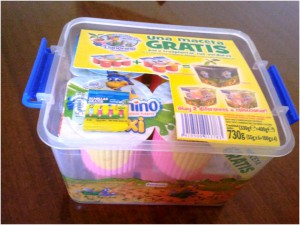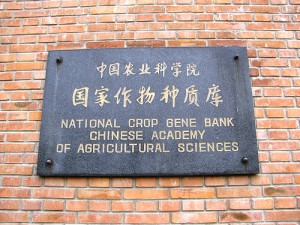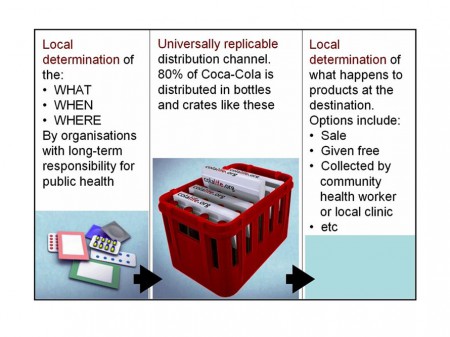- CIP’s high-tech genebank.
- “The project’s eventual aim is to plant several thousand trees at sites across Perthshire to act as a ‘living gene bank.'” What, because normally genebanks are dead?
- Millennium Seed Bank joins ICRAF’s BusyTrees thing. Which you can follow in about a million different social networking ways.
- Conservation Magazine does a number on crop improvement. Wait, what? Conservation Magazine? Yep, and with teaching resources.
- Fenugreek, barkeep, and make it a double.
- Ancient chocolate and corn routes.
- What species distribution models do you like?
Yoghurt seeds and other unlikely alliances
We’re very happy to welcome back to the fray our occasional contributor Jacob van Etten. Don’t be such a stranger in the future, Jacob.
 My daughter’s Danonino yoghurt, bought at our local Spanish supermarket, came with a tiny package of lettuce seeds and a nice plastic box to plant the seeds into. In my particular household, the seeds fell on barren ground, as it were, but I think it is a great idea. 1
My daughter’s Danonino yoghurt, bought at our local Spanish supermarket, came with a tiny package of lettuce seeds and a nice plastic box to plant the seeds into. In my particular household, the seeds fell on barren ground, as it were, but I think it is a great idea. 1
According to the package, Danone produced 300,000 of these boxes with seeds for the Spanish market. I did some googling to find out more about this campaign and apparently it is not limited to Spain. The seeds are also stirring things up in places like Tampa Bay, where the seeds were tried by a playgroup. The blog post on the seeds got 27 comments last time I checked it. This is the very first one:
gabby reid
March 13, 2011 at 9:50 pm
oh my goodness.I grew the plant and it worked my name is gabby reid and i am 10 years old.very mature for my age and did not think it was gonna work beacause usually food makers for kids never actually work. But now I know that danonino can be trusted.And when I see that danonino says somthing is included and it will work and I am sure that people that buy the same thing I got,they will trust you too.
I think that the Danone marketeers can be happy about the effect of the seeds campaign on 10-year olds. (Or they are very good at writing bogus posts themselves.) Apart from that, the seeds also lead to some genuine learning about agricultural techniques. This is another comment on the same post:
Traci Lovelady
May 28, 2011 at 6:31 pm
Just curious… we got carrot seeds & they are growing great, but honestly how are carrots supposed to grow in that little yogurt cup??whatsdo2
May 28, 2011 at 7:29 pm
When they get large for the cup, you will need to move them to a large pot or into your garden.
Can this fantastic experience be repeated in areas that are more food insecure than Spain and Florida?
I think it could have an enormous impact if we could fill those seed packages with hundreds or different varieties to be tried by farmers, young and old. Now that would boost on-farm crop diversity. The seeds could become the talk of the town, as in Tampa Bay. Farmers might start swapping the packages, or accumulating them to make up a more substantial seed lot. They could try to harvest seed of the varieties they like best, and recycle the seed. They could even become interested in actually buying some seed, if they really liked the variety.
Of course, we would need to work a bit more on the details. One problem would be how to get those seeds to farmers in remote areas in, say, Africa. But here another solution presents itself: use existing distribution channels. Those little seed packages just weigh a few grams, so they can be shipped together with other products. If you can get a Coca Cola to the remotest African village, you should be able to get some tiny seed packages there, too, right?
Well, that may seem like a tired idea, that we should imitate the logistics of bottled soft drinks. But people who are thinking about ways to get medicines into rural areas have some very creative ideas in this area. Colalife (“building unlikely alliances to save children’s lives”) is pushing the idea to put medicines in boxes that fit very nicely on top of the bottles in a Coca Cola crate.
So the question is: can we build some “unlikely alliances” for diverse seed distribution, too?
Nibbles: Seed savers, Lemons, Assam Rice, Striga control, Amaranth, Bearded pigs, Banana, Early nutrition
- Seed savers: everyone’s got an angle, from Seeds of Hope and Change to Seed Bank Bingo.
- Italian lemons enjoying a renaissance. In California, natch.
- India registers Assam farmers’ traditional rice varieties. In other news, rice water “is also used as shampoo, according to community elders”.
- US$9 million to “implement and evaluate four approaches” to controlling Striga in Africa. One day we’ll know.
- Denver Botanic Gardens does amaranth.
- Evolution of bearded pigs. Good to know. Good to eat?
- Bioversity banana team guest blogs at Annals of Botany. But surely they have a blog of their own. No, wait…
- Agriculture is bad for your health.
Brainfood: Soil, Seed aging, Organic sustainability, Yaquis, Garlic, Rice bean, Ethiopian livestock, Sweet potato intercropping, PES
- Long-term effect of tillage, nitrogen fertilization and cover crops on soil organic carbon and total nitrogen content. No till is better than conservation tillage.
- Catalase is a key enzyme in seed recovery from ageing during priming. It sure is. Good to know.
- Sustainable agriculture: A case study of a small Lopez Island farm. The authors conclude: “the need for future targeted nutrient inputs cannot be ruled out for sustainable long-term production”.
- Evolution of the knowledge system for agricultural development in the Yaqui Valley, Sonora, Mexico. They’re innovative, and diversity promotes agility.
- Changes in phenolic compounds in garlic (Allium sativum L.) owing to the cultivar and location of growth. Don’t hold your breath; only 10 varieties.
- Morpho-physiological and nutritional characterization of rice bean (Vigna umbellata). Now that’s what I call science; 30 varieties.
- Rural livestock asset portfolio in northern Ethiopia: a microeconomic analysis of choice and accumulation. Many, many factors come into play.
- Sweet potato (Ipomoea batatas L.)-based strip intercropping: I. Interspecific interactions and yield advantage. Almost every intercrop improves yield and bottom line.
- Should payments for biodiversity conservation be based on action or results? A model says: “It depends.”
China establishes (another) national genebank
China established its first national gene bank on Friday in south China’s city of Shenzhen with the support of the Beijing Genomics Institute (BGI), officials said. With the establishment of the National Gene Bank in Shenzhen, China will be able to better protect, research and utilize its precious genetic resources, boosting the genetics industry and safeguarding the country’s genetic information, said Qi Chengyuan, head of the high-tech industry department of the National Development and Reform Committee (NDRC).
 Eh? What does that make CAAS’s National Crop Gene Bank? And the genebank at the Kunming Institute of Botany, China’s largest, apparently? What are they? Chopped liver? 2
Eh? What does that make CAAS’s National Crop Gene Bank? And the genebank at the Kunming Institute of Botany, China’s largest, apparently? What are they? Chopped liver? 2
Genebank bubble indeed.
